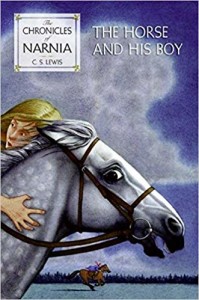How C. S. Lewis and Shasta can Help Kids Gain New Perspective on Difficult Situations
If I’ve learned anything about kids after working in a public elementary school for nearly fifteen years, it’s that many kids are cheerful Piglets, some are gloomy Eeyores, and a few are like C. S. Lewis’ Shasta (from The Horse and His Boy), who tend to see the very worst in every situation.
If it’s sunny outside, the bright light hurts their eyes. If someone checks out the library book they wanted, they throw a tantrum and refuse to check out anything else. If a friend wants to play with someone else at recess, they must not want to be their friend ever again. Disasters, all! Some kids, of course, have true miseries to deal with–poverty, even tragedies.
What to do? How can we help kids look at things another way, a way that leads to hope and maturity? Through books, of course! Reading great fiction, especially together, provides a way for kids to journey with the main characters as they experience ups, downs, and the unfairness of it all. Best of all, they can emerge at the other end of the story a little wiser and maybe even with a new perspective on life.
C. S. Lewis’s The Horse and His Boy is a great story for helping kids understand that God might have a different way of looking at things. Shasta, in tears, doesn’t understand why so many bad things have happened to him, until he runs into a lion who sets him straight:
“I do not call you unfortunate,” said the Large Voice.
“Don’t you think it was bad luck to meet so many lions?” said Shasta.
“There was only one: but he was swift of foot.”
“How do you know?”
“I was the lion.: And as Shasta gaped with open mouth and said nothing, the Voice continued. “I was the lion who forced you to join with Aravis. I was the cat who comforted you among the houses of the dead. I was the lion who drove the jackals from you while you slept. I was the lion who gave the Horses the new strength of fear for the last mile so that you should reach King Lune in time. And I was the lion you do not remember who pushed the boat in which you lay, a child near death, so that it came to shore where a man sat, wakeful at midnight, to receive you.”
Shasta did not like the man who raised him very much, but there it was, the truth as Aslan saw it—whatever his failings, the man had saved his life and taken him in. Many children in our churches and communities are going through difficult times. Reading stories like this might help them see that God is with them after all, in the midst of their troubles, and that He loves them very much.
Sonja Anderson


Comments
How C. S. Lewis and Shasta can Help Kids Gain New Perspective on Difficult Situations — No Comments
HTML tags allowed in your comment: <a href="" title=""> <abbr title=""> <acronym title=""> <b> <blockquote cite=""> <cite> <code> <del datetime=""> <em> <i> <q cite=""> <s> <strike> <strong>